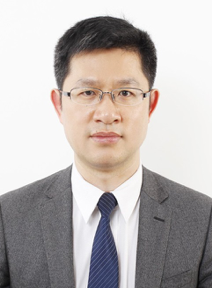
Mr. Xing’an GE is the President and CEO of China Emissions Exchange Shenzhen (CEEX), and the Secretary-General of Shenzhen Green Finance Committee (Shenzhen GFC). He is also the member of the Advisory Committee of Sustainable Finance under UNDP China. With more than ten years of experience in climate change and carbon trading, Mr. GE has been deeply involved in the design and operation of Shenzhen Emission Trading Scheme (SZ ETS). He joined the Financial Standards Working Group of China Financial Standardization Technical Committee, and completed the study on green private equity (PE) funds for 2018 G20 Green Finance Working Group. He also led the SZ GFC to join, on behalf of Shenzhen, the International Network of Financial Centers for Sustainability (FC4S) launched by UNEP. He graduated from the University of Massachusetts Amherst with a Master degree in public policy and administration and a Bachelor degree in Law from Nanjing University.

The Interim Regulations on the Management of Carbon Emissions Trading (Draft for Comments) issued by the Ministry of Ecology and Environment in April 2019 sent a positive signal to the market since China officially launched its plan to build a national carbon market in December 2017. What role will the Shenzhen EEX play, and what are the opportunities and challenges, once the national carbon market is fully functional?
Since Shenzhen firstly initiated its carbon trading pilot on June 18, 2013, it has undergone over five compliance periods smoothly. Although the smallest pilot in size, Shenzhen has ranked first in market liquidity consistently and this trend continues annually.
Shenzhen will advance its pilot carbon market and continue to play a role in achieving the goal of capping the total amount of local greenhouse gas emission. Led by the municipal government, Shenzhen will explore a new model for synergy of pollutant control, energy conservation, and emissions reductions that would make better use of the ETS, combine pollution control with ecological conservation, and provide opportunities for nurturing the local infant carbon management services industry. To boost business growth, the Shenzhen pilot will provide experiences for the national carbon market as other industries join the national ETS, compel low-carbon transformation for local enterprises, and provide local businesses with investment and financing channels for low-carbon development.
The Shenzhen pilot faces both opportunities and challenges as the national carbon market becomes fully operational. As the smallest among the pilots, market size is the biggest challenge. Compared to other pilots, Shenzhen is characterized by having more green-tech development and a low number of energy-intensive industries. This signifies that Shenzhen will have a relatively small number of industries and enterprises covered by China’s national carbon market.
Yet, these challenges present opportunities at the same time. As mentioned, the Shenzhen market is distinctively differentiated from the national carbon market, but bearing these regional characteristics in mind, Shenzhen will fully leverage its rich and valuable experiences in terms of its legal system, market designing, capacity building and innovation of carbon financing products and services to facilitate smooth transition to the national carbon market. It also plans to expand the focus of emissions controls from just the industrial sector to the building and transport sectors as well as target individual behaviors that produce high emissions.
Fintech is playing a transformative role in the financial system as well as green and sustainable development. China is achieving rapid growth in this space. China’s State Council recently issued the Outline Development Plan for the Guangdong-Hong Kong-Macao Greater Bay Area (GBA) and indicated it would launch a fintech pilot in Shenzhen. What are your thoughts on the application of fintech in support of green finance and sustainable development?
As an early adopter of China’s fintech innovation model, Shenzhen is a leader in terms of the number of fintech firms, industrial penetration, and local government support for fintech development. Under the GBA framework, the green finance development in Shenzhen will focus on using the cluster of financial institutions in the area to boost fintech in green finance and sustainable development.
Renmin University estimated the demand for green finance in 2017 to be 2.186 trillion RMB, but actual green financing for that year was only 0.94 trillion RMB. The gap between green finance supply and demand remains due to firmly held beliefs in the economics around green business and green projects that remain unchanged, and how financial institutions perceive them in terms of risk assessment. But fintech can realize increased creditability, greater efficiency, lower costs, and more control of risks. It can bridge demand for and supply of green finance, strengthen control of corporate operational risk and industrial risk, and help financial institutions innovate their risk assessment and decision-making models. Shenzhen will include fintech applications to create an innovative model of green finance to serve the real economy and facilitate supply-side structural reform.
The Shenzhen GFC was officially launched in June 2017 and you were responsible for its implementation. What role will Shenzhen GFC play in promoting green finance development in Shenzhen, facilitating the development of the GBA, and providing services for greening the Belt & Role Initiative? What do you have on the agenda?
Since its establishment, the Shenzhen GFC has been devoted to building a platform to coordinate business, government, and regulatory authorities for the development of green finance and ecological conservation. Based on Shenzhen’s economic and industrial characteristics, the Shenzhen GFC has proposed a green finance innovation program to build the city’s new green finance capacity and fill the gaps in China’s green finance development. Additionally, the Shenzhen GFC has advocated to institutionalize Shenzhen’s green finance development plan, supported the Futian district’s efforts to be included in the second batch of national green finance pilot zones, assisted the Shenzhen Sub-branch of People’s Bank of China (PBOC) with rediscount preferred loan for green SMEs, and organized business promotion activities between banks and green businesses.
The Shenzhen GFC has also actively collaborated with Hong Kong and other international partners to respond to the ideas of ecological conservation, green development, and sustainability featured in plans for the GBA. Engagement in the region included joint research on green finance, introducing innovative green finance products and services, raising awareness, strengthening capacity building, and advancing the implementation of green finance policies. The Shenzhen GFC aims to replicate the best practices of Shenzhen in the GBA area and nationwide, support the national strategy of greening the Belt and Road, and facilitate finance to play a more active role in green transformation and ecological conservation.
Going forward, the Shenzhen GFC will focus on six things:
- Advance cooperation for greater integration of green finance in the GBA
- Promote implementation of Shenzhen’s policies on green finance
- Explore development of a sustainable green finance model and green finance’s role in serving the real economy by leveraging the Green Finance for Real Economy Laboratory jointly launched by the Shenzhen GFC and the FC4S
- Strengthen green finance capacity building
- Ignite green finance development including helping Shenzhen’s core financial area develop a distinctive green finance model, championing green finance innovation and practice in Qianhai pilot free trade zone, assisting the Shenzhen EEX to develop innovative green finance business, and building capacity with more green finance products
- Support national standards development by participating in PBOC’s studies of green finance progress and green finance terminology, International Organization for Standardization’s (ISO) TC322 sustainable finance terminology, and UNDP SDG sustainable bond standard
Developing a nationally unified and internationally compatible green finance standards system is one of the PBOC’s priority tasks on green finance and you are taking the lead on the study for developing green fund standards. What are the opportunities and challenges for green funds, especially green PE funds in China?
Given the long investment horizons and relatively high risks that characterize the green industries and the increasing demand for green capital, only relying on traditional financing channels such as bank credit and bonds have proved insufficient to close the gap. Developing green funds is imperative. A green PE fund has three features—
- Long duration to provide long-term and stable financing support for the green industries
- Professional resources to help the green business grow rapidly by providing resource and management support
- Focus on long-term returns that unlocks financing channels to near-term unprofitable companies, but that have great long-term potential
Therefore, green funds, particularly green PE funds, can diversify risks thorough professional asset allocation and portfolios can grow with “green” assets, allowing investors to participate in green development and reap its benefits.
Challenges faced by green funds include lack of the standards for evaluation and certification acceptable at home and abroad, and balancing between the greenness of an investment and its return risk ratio. As part of the national green finance standardization work, with the support of PBOC research bureau and the Energy Foundation, Shenzhen GFC led the research behind the Key Guidelines on the Green Private Equity Fund Standard (draft for discussion) completed in May with participation of Shenzhen EEX, Tsing Capital, Eco Capital and Goolun Capital. As a representative of China, I attended the first meeting of the ISO Standards Committee’s TC 322 Sustainable Finance in March, and reported the progress of our work to the group, generating much attention. With establishment of a set of green fund evaluation and certification standards, we hope that it will be able to steer government policies toward supporting and incentivizing the growth of green funds, provide channels for investors to participate in green projects and enjoy returns, resulting in greater support and more financing towards green industries.
As a leader in the carbon market and green finance space, how do you advocate living a low carbon lifestyle in your daily life?
I am a great believer in sports and exercise. Apart from jogging, I often do other sports, like body-building and hiking. In my daily life, if walking can get me to my destination, then I will not drive. And when not at work, then I wear lightweight clothing like sport apparel to reduce my air conditioning needs. I also care about resource recycling, including recycling of old clothes, electrical appliances, and plastic waste. I have joined my colleagues in a number of community activities like the Shenzhen Mill 100 Kilometers, Low-Carbon Walk and marches organized by the Shenzhen Yantian district and the SEE Foundation, to help raise public low-carbon awareness and cultivate public low-carbon behavior. The hope is that more and more people—the youth especially—pay attention to low-carbon development and the carbon trading market.


